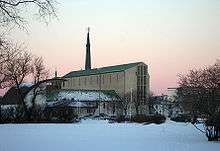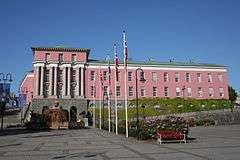Gudolf Blakstad
Gudolf Blakstad (19 May 1893 – 22 November 1985) was a Norwegian architect. He was noted for his work in the transition between neo-classicism and functionalism in Norwegian architecture. [1]



Biography
Blakstad was born in Gjerpen, Norway. He was the son of Wilhelm Eriksen Blakstad (1863-1963) and Gunvor Kjos (1855-1932). Blakstad was educated at the Norwegian Institute of Technology where he graduated in 1916. From 1922 he started his own practice in Oslo together with Arnstein Arneberg and Herman Munthe-Kaas. He would maintain a partnership with Herman Munthe-Kaas in the architectural firm Blakstad og Munthe-Kaas Arkitekter for more than 50 years. During the period 1922-1960, they participated in 66 contests, won prizes in 33 of them, of which all 22 were first prizes. The firm ceased in 1989.[2][3]
The firm collaborated on several significant assignments in Norway including Kunstnernes Hus for which they were awarded the Houen Foundation Award in 1931.[4] Their work also included the City Hall in Haugesund (1931), Elgeseter Bridge (1951) in Trondheim, Bodø Cathedral (1956) in the Diocese of Sør-Hålogaland and Alfaset chapel (1972) in Oslo. He also drew Det Nye Teater with Jens Gram Dunker.[5][6][7]
References
- Johnsen, Espen. "Gudolf Blakstad". Norsk biografisk leksikon. Retrieved August 15, 2016.
- Jens Christian Eldal. "Gudolf Blakstad". Norsk kunstnerleksikon. Retrieved August 15, 2016.
- "Blakstad og Munthe-Kaas Arkitekter". Kunsthistorie. Retrieved October 1, 2017.
- "Houens diplom. 1931. Kunstnernes hus. Gudolf Blakstad og Herman Munthe-Kaas". lokalhistoriewiki.no. Retrieved October 1, 2017.
- "Gudolf Blakstad". Store norske leksikon. Retrieved August 15, 2016.
- Kunstnernes Hus (Norsk kulturråd )
- Bodø domkirke (Arkitekturguide Nordnorge og Svalbard)